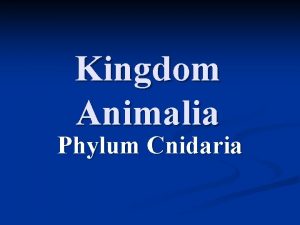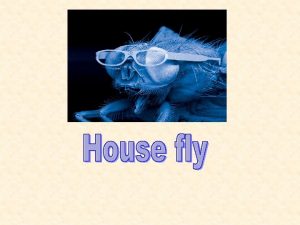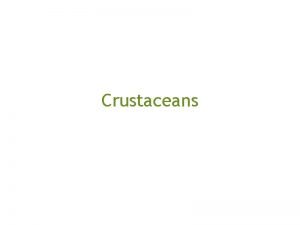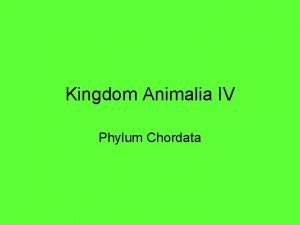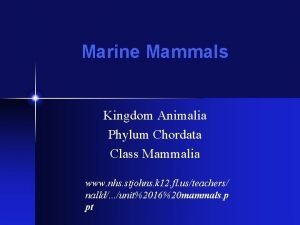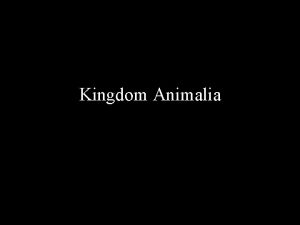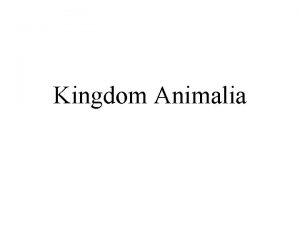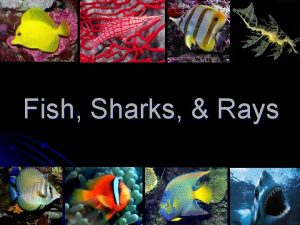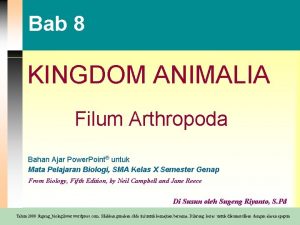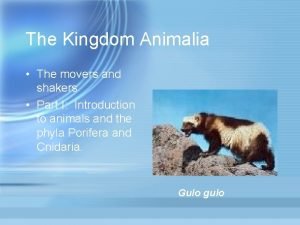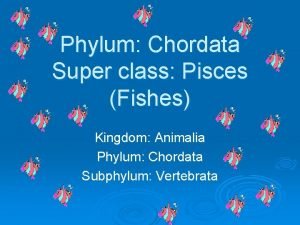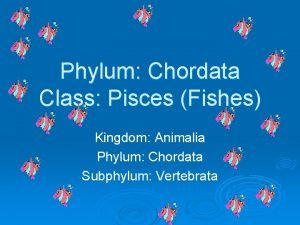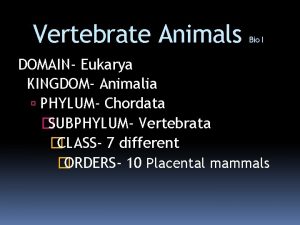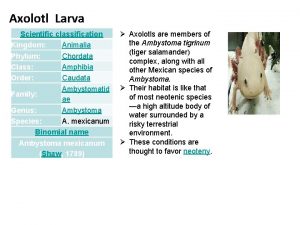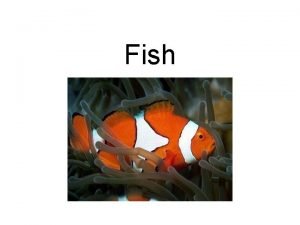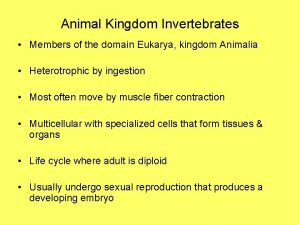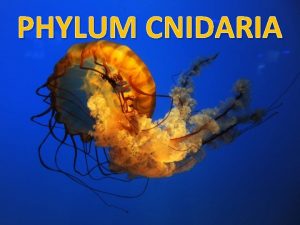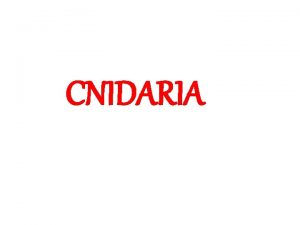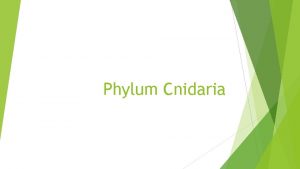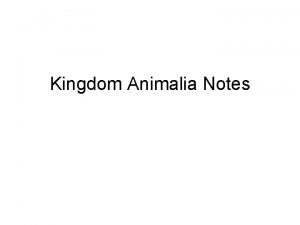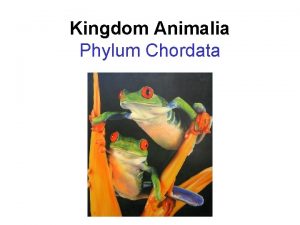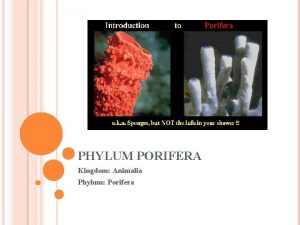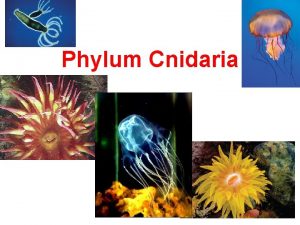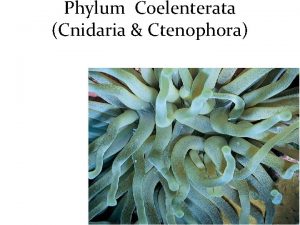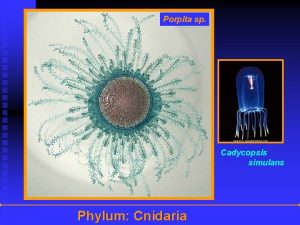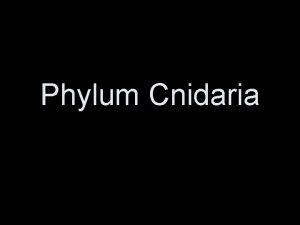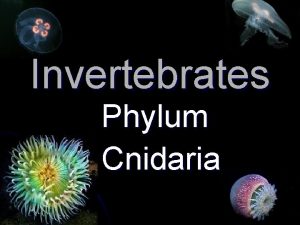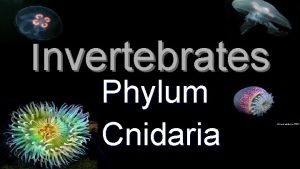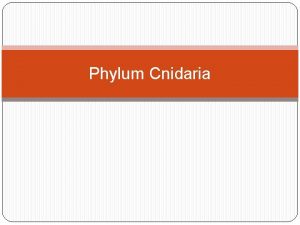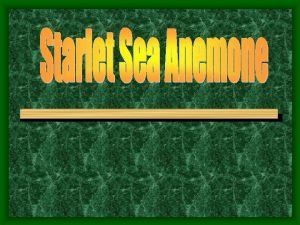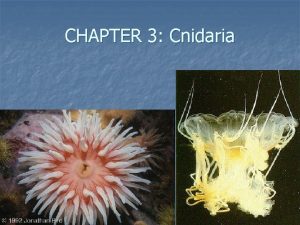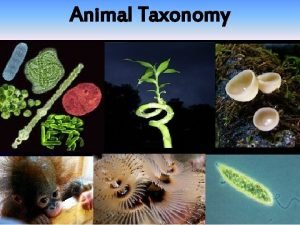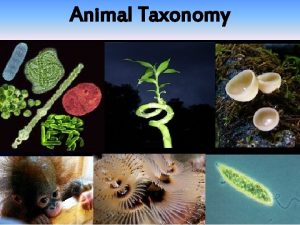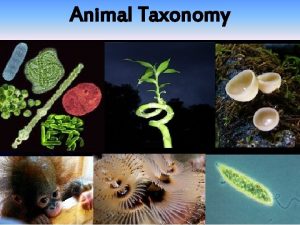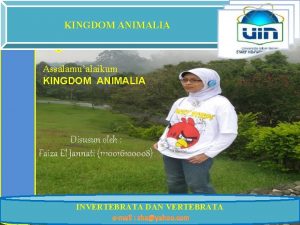KINGDOM ANIMALIA Phylum Cnidaria Phylum Cnidaria The phylum


























- Slides: 26

KINGDOM ANIMALIA Phylum Cnidaria

Phylum Cnidaria The phylum name comes from Cnidaria, the Greek word for nettle, a plant that has stinging hairs.

Members of the Phylum Cnidaria …exhibit radial or biradial symmetry. …are all aquatic (typically marine, but some freshwater). …are sessile, free-floating, or weak swimming. …have a tissue-level organization. …have a primitive nervous system. …have stinging cells.

Question Which of the following characteristics sets the members of the phylum Cnidaria apart from all other animals? A. They are all aquatic. B. They have stinging cells. C. They are all multicellular. D. They are sessile as adults.

General Organization Cnidarian bodies are organized around the gastrovascular cavity, where digestion takes place. Two layers of cells: gastrodermis (lining the digestive tract) and epidermis (outer layer) Mesoglea: jelly substance in between the two cell layers.

Question In a cnidarian, the jelly substance in between the two cell layers is called A. B. C. D. mesoglea cnidoglea epidermis gastrodermis

Reproduction Sexual reproduction: gametes are shed directly into the water. Asexual reproduction: usually by budding, some by fission.

Question Cnidarians reproduce in all of the following ways, EXCEPT A. B. C. D. Asexual fission Asexual budding Sexual regeneration Sexual reproduction involving egg and sperm

Life Cycles: Polyp and Medusa Cnidarians generally alternate between sessile polyps that reproduce asexually and swimming medusae that reproduce sexually. One of these stages is missing in many forms.


Question True or False: This picture represents the medusa body plan of a cnidarian.

Stinging Tentacles The tentacles of all cnidarians produce nematocysts, organelles that can discharge threads to entangle, penetrate, or poison prey. The tentacles are composed of cells called cnidocytes, which contain the nematocysts.

Cnidocyte

Question In a cnidarian, the cnidocytes are used for A. swimming B. digesting food C. paralyzing prey D. sensing predators

Feeding and Digestion Cnidarians prey on a variety of appropriate-sized prey. Prey is normally drawn into the gastrovascular cavity by the tentacles. Here, gland cells discharge enzymes onto the food.

Question Where does digestion take place for cnidarians? A. B. C. D. In the tentacles In the epidermis Outside the body In the gastrovascular cavity

Four Important Cnidarian Classes 1. Class Hydrozoa Mostly marine Alteration of generation (polyp and medusa stages) is usually exhibited Includes hydroids, fire corals, and Portugese man-of-war

Hydrozoan: Hydra

Four Important Cnidarian Classes 2. Class Scyphozoa Dominant stage is the medusa Polyp is absent or reduced Cup-shaped umbrellas Includes true jellyfish

Scyphozoa: Aurelia labiata

Four Important Cnidarian Classes 3. Class Cubozoa Like jellyfishes, but they have cubical umbrellas. Some may deliver fatal stings. Includes the box jelly, one of the 10 most venomous organisms on earth.

Cubozoans

Four Important Cnidarian Classes 4. Class Anthozoa Polyps with a flowerlike appearance No medusa stage All marine, found all over the world Includes sea anemones, corals, sea fans, and sea whips.

Anthozoans: Corals

Anthozoans: Anemones

Economic Importance Reef-building corals provide habitat for fish and other animals that are important as food sources for humans. Coral reefs are tourist attractions and coral rocks are used as building materials and jewelry.
 Characteristics of cnidaria
Characteristics of cnidaria Kingdom animalia phylum cnidaria
Kingdom animalia phylum cnidaria Diptera
Diptera Kingdom animalia phylum arthropoda
Kingdom animalia phylum arthropoda What are chordata
What are chordata Kingdom animalia phylum chordata
Kingdom animalia phylum chordata Kingdom animalia phylum chordata class mammalia
Kingdom animalia phylum chordata class mammalia Old kingdom middle kingdom new kingdom
Old kingdom middle kingdom new kingdom Old kingdom middle kingdom new kingdom
Old kingdom middle kingdom new kingdom Youtube
Youtube Capital of egypt during the old kingdom
Capital of egypt during the old kingdom Animalia characteristics
Animalia characteristics Animalia cladogram
Animalia cladogram Animal characteristics
Animal characteristics What does shark skin feel like
What does shark skin feel like Arthropoda
Arthropoda When classifying organisms orders are grouped together into
When classifying organisms orders are grouped together into Nine phyla of kingdom animalia
Nine phyla of kingdom animalia Kingdom pisces
Kingdom pisces Animalia cell type
Animalia cell type Pisces in animal kingdom
Pisces in animal kingdom Domain eukarya kingdom animalia
Domain eukarya kingdom animalia What are axolotls classified as
What are axolotls classified as Fish phylum
Fish phylum Domain eukarya kingdom animalia
Domain eukarya kingdom animalia Ciri ciri umum kingdom animalia
Ciri ciri umum kingdom animalia Kingdom animalia cell structure
Kingdom animalia cell structure

